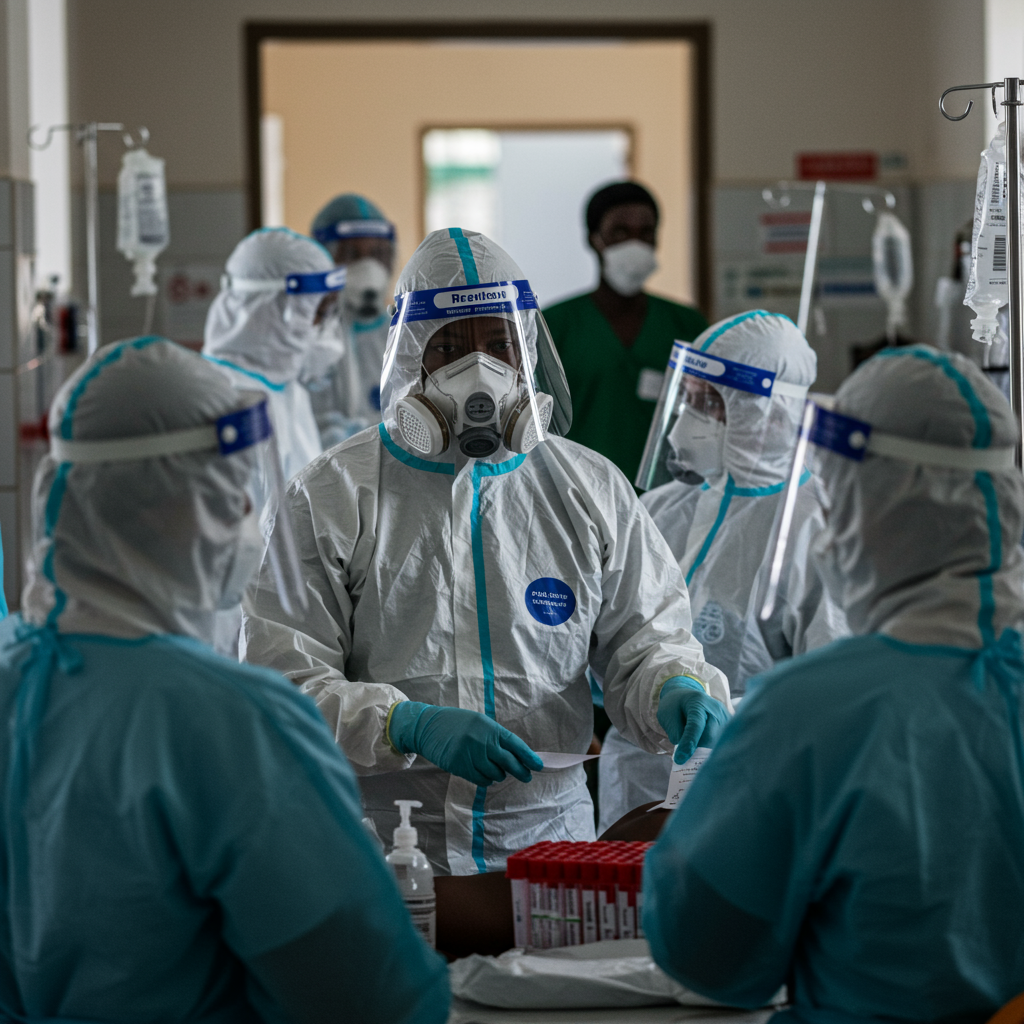The Democratic Republic of Congo (DRC) is once again on high alert following the urgent declaration of a new Ebola virus disease (EVD) outbreak in its Kasai Province. On September 4, 2025, health authorities confirmed the devastating news, marking the DRC’s latest battle against this formidable pathogen. This emerging public health crisis underscores the persistent threat of EVD in the region and highlights the critical need for immediate, coordinated action to safeguard communities.
This declaration follows the detection of 28 suspected Ebola cases and 15 associated deaths in the Bulape and Mweka health zones of Kasai Province. Alarmingly, this toll includes four dedicated health workers, emphasizing the severe risks faced by frontline responders. The provisional figures are subject to change as intensive investigations continue, but the urgency of the situation is undeniable. Patients presented with a range of severe symptoms, including persistent fever, vomiting, diarrhoea, and hemorrhagic manifestations, characteristic of EVD.
Unraveling the Outbreak: Ebola Zaire Confirmed
Prompt and decisive action led to the rapid identification of the causative agent. Samples tested on September 3, 2025, at the country’s National Institute of Biomedical Research (INRB) in Kinshasa, conclusively confirmed the outbreak’s origin: Ebola Zaire. This specific strain of the Ebola virus is notorious for its virulence and historical impact in previous epidemics. The swift laboratory confirmation allowed for immediate, targeted public health interventions tailored to this particular variant. Understanding the specific strain is crucial for deploying effective treatments and vaccines.
Ebola Virus Disease, while rare, is a severe and often fatal illness in humans. It transmits to people through close contact with the blood, secretions, organs, or other bodily fluids of infected animals, with fruit bats considered its natural hosts. Human-to-human transmission occurs through direct contact with blood or body fluids from an individual who is sick with or has died from Ebola, or from objects contaminated with such fluids. A critical epidemiological characteristic is that the virus only becomes contagious once an infected individual begins to manifest symptoms, a key factor guiding contact tracing and isolation efforts. In some outbreaks, the mortality rate can reach a staggering 90 percent, underscoring the lethal potential of this virus.
Swift Response: National and International Collaboration Intensifies
In the face of this unfolding crisis, an immediate and robust response has been mobilized. A national Rapid Response Team, comprising experts from the DRC’s health sector, was swiftly deployed to Kasai Province. This national effort is significantly bolstered by the participation of specialists from the World Health Organization (WHO), bringing unparalleled expertise in critical areas. These international experts cover epidemiology, infection prevention and control (IPC), laboratory diagnostics, and comprehensive case management. Their combined mission is to rapidly strengthen disease surveillance systems, enhance treatment protocols, and fortify infection prevention and control measures within local health facilities to curb further transmission.
Dr. Mohamed Janabi, WHO Regional Director for Africa, underscored the resolute commitment to containing the virus’s spread and protecting communities. “We’re acting with determination to rapidly halt the spread of the virus and protect communities,” he affirmed. Dr. Janabi highlighted the DRC’s extensive and “long-standing expertise in controlling viral disease outbreaks,” expressing confidence that close collaboration with health authorities would enable a rapid scale-up of key response measures to terminate the outbreak as quickly as possible. This collective determination is a cornerstone of the urgent public health strategy.
Overcoming Logistical Hurdles and Delivering Aid
The affected region in Kasai Province presents significant logistical challenges. The area is notoriously difficult to reach, often requiring at least a full day’s drive from Tshikapa, the provincial capital of Kasai, and offering limited air transport links. Despite these hurdles, the WHO is proactively delivering two tonnes of critical emergency supplies. These essential resources include:
Personal Protective Equipment (PPE): Crucial for safeguarding frontline health workers.
Mobile Laboratory Equipment: To facilitate rapid, on-site diagnostics and testing.
- Essential Medical Supplies: A range of other necessary resources to support patient care and infection control.
- www.afro.who.int
- www.aljazeera.com
- www.vax-before-travel.com
- www.ndtvprofit.com
- sharjah24.ae
These supplies are vital for equipping response teams and local health facilities, enabling them to operate effectively in challenging conditions. The swift delivery of these resources demonstrates a proactive approach to overcoming geographical barriers and ensuring that support reaches those who need it most.
DRC’s Enduring Battle Against Ebola: A History of Resilience
The current Ebola outbreak in DRC is a somber reminder of the nation’s recurring encounters with this viral threat. The disease was first identified in the country in 1976, and since then, the DRC has faced over 15 distinct EVD outbreaks, making it one of the most experienced nations globally in managing such crises. This extensive history has cultivated deep expertise within the country’s health authorities, which is now being leveraged to its full extent.
The DRC’s most recent prior outbreak occurred in the north-western Equateur province in April 2022. Thanks to robust and concerted efforts by health authorities and international partners, that outbreak was swiftly brought under control in under three months. Kasai Province itself is not unfamiliar with Ebola, having reported previous outbreaks in 2007 and 2008. This institutional memory and accumulated experience are invaluable assets in the current response, providing crucial lessons learned and established protocols. The nation’s ability to rapidly mobilize and coordinate is a testament to its resilience in the face of ongoing public health challenges.
Harnessing the Power of Vaccines and Treatments
A critical component of the DRC Ebola outbreak response is the strategic deployment of medical countermeasures. The country maintains a national stockpile of EVD treatments, ensuring immediate access to therapeutic options for those infected. Furthermore, 2,000 doses of the Ervebo Ebola vaccine, specifically effective against the Ebola Zaire strain, are already prepositioned in Kinshasa. These vaccine doses are slated for rapid transportation to Kasai Province.
Upon arrival, a targeted ring vaccination strategy will be implemented. This involves vaccinating contacts of confirmed cases and all frontline health workers to create a protective barrier against the virus’s spread. The Ervebo vaccine received US FDA approval in September 2025, a significant development enhancing its use in outbreak responses. This immediate availability and strategic deployment of an effective vaccine underscore the advanced preparedness and commitment to containing the outbreak swiftly. Additionally, advancements in diagnostics, such as Aptitude Medical Systems’ Metrix® platform—developed in partnership with BARDA—aim to provide rapid detection and differentiation between Ebolavirus and Marburgvirus species, further bolstering the capacity for timely and accurate outbreak management.
Outlook and Ongoing Vigilance
Given the ongoing transmission dynamics, authorities anticipate that the number of cases is likely to increase. Consequently, response teams, working in close collaboration with local health personnel, are diligently focused on identifying all potentially infected individuals. The goal is to ensure they receive timely care, thereby preventing further spread and protecting the broader population. The collective efforts of national and international teams emphasize the critical importance of rapid, well-coordinated action, robust community engagement, and timely medical intervention. These elements are paramount for not only containing the Ebola virus but also for safeguarding vulnerable populations against its devastating impact. Continuous monitoring and swift adaptation of response strategies will be crucial in the weeks and months ahead. The commitment remains unwavering: to end this outbreak as quickly as possible.
Frequently Asked Questions
What are the key symptoms of Ebola Virus Disease, and how is it transmitted?
Ebola Virus Disease (EVD) is characterized by severe symptoms including fever, vomiting, diarrhoea, and haemorrhage. It is a rare but often fatal illness. EVD initially transmits from infected animals, primarily fruit bats, to humans through close contact with their blood, secretions, organs, or other bodily fluids. Human-to-human transmission occurs through direct contact with blood or body fluids of a person who is sick with or has died from Ebola, or with objects contaminated by such fluids. Importantly, the virus is only contagious once an infected individual begins to show symptoms.
Which organizations are involved in the emergency response to the DRC Ebola outbreak in Kasai Province?
The response to the latest Ebola outbreak in Kasai Province is a collaborative effort. The Democratic Republic of Congo’s national health authorities have deployed a Rapid Response Team. This team is significantly augmented by experts from the World Health Organization (WHO), who specialize in epidemiology, infection prevention and control, laboratory analysis, and case management. Provincial risk communication experts are also engaged to work with affected communities. This multi-agency, multidisciplinary approach ensures comprehensive coverage of surveillance, treatment, and community engagement.
How are vaccines and treatments being deployed to control this Ebola outbreak?
The DRC is utilizing a multi-pronged medical strategy. The country maintains a national stockpile of Ebola treatments for infected individuals. Crucially, 2,000 doses of the Ervebo Ebola vaccine, effective against the confirmed Ebola Zaire strain, are positioned in Kinshasa and are being rapidly moved to Kasai Province. A “ring vaccination” strategy will be implemented, targeting contacts of confirmed cases and frontline health workers to create a protective barrier against the virus. The recent US FDA approval of the Ervebo vaccine in September 2025 further strengthens its deployment.
The declaration of this Ebola outbreak in DRC once again tests the resilience and expertise of the nation and its global health partners. With the rapid deployment of national and international response teams, critical supplies, and proven medical countermeasures like the Ervebo vaccine, there is a determined effort to contain the virus swiftly. The experience of the DRC, coupled with robust global collaboration, offers a beacon of hope in this challenging public health emergency. Continued vigilance, community engagement, and sustained support will be paramount in bringing this latest outbreak under control and protecting the lives of thousands.




